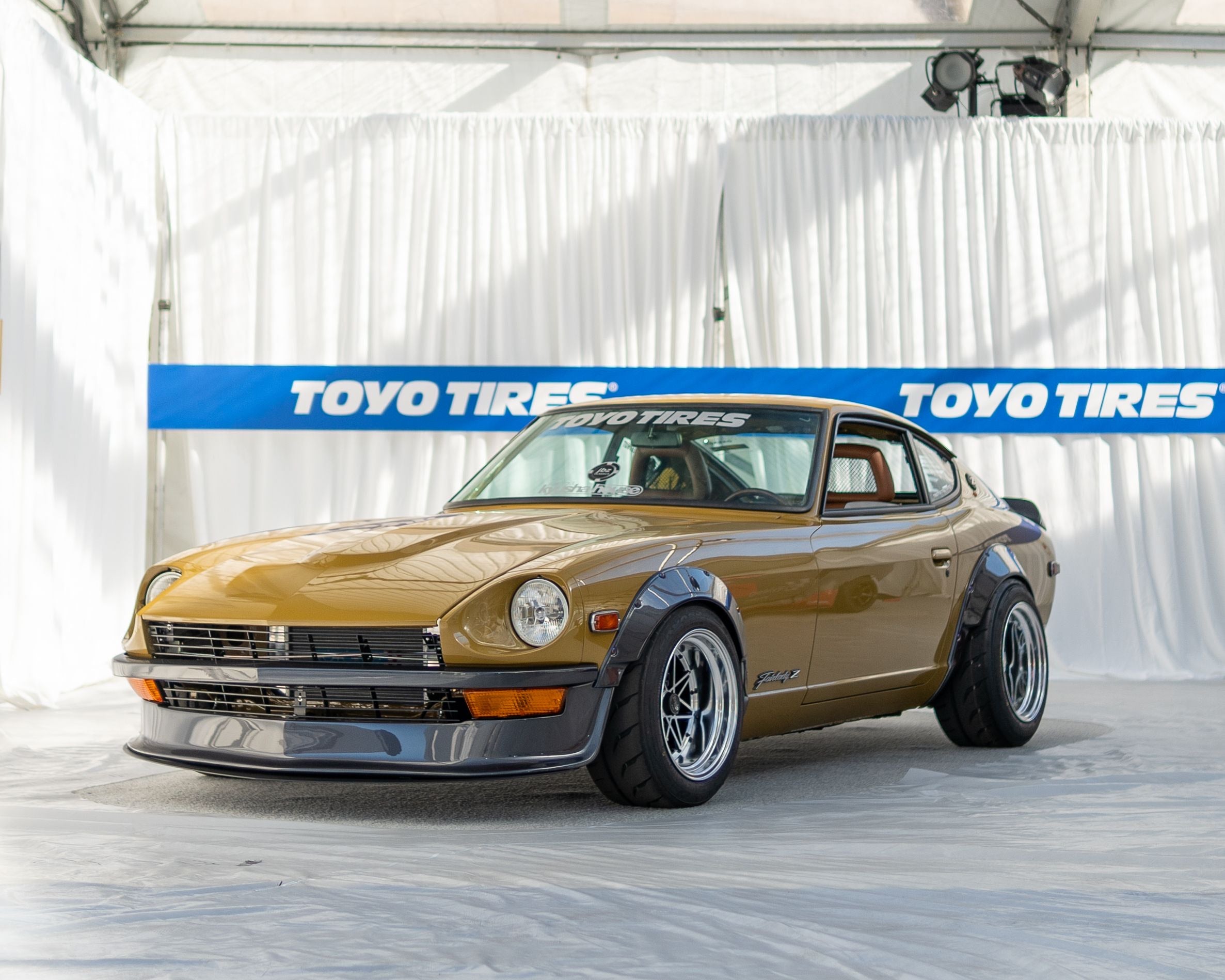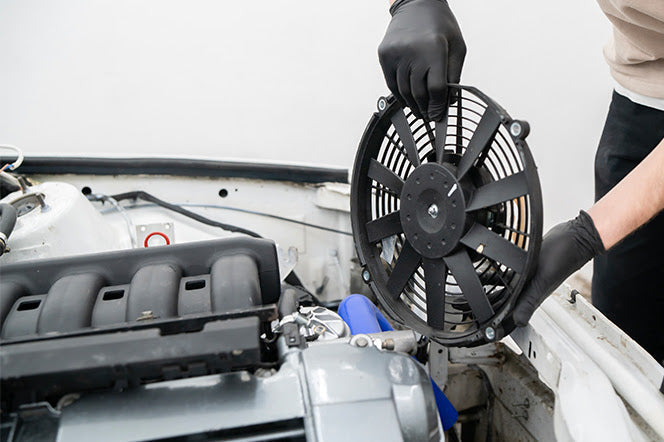The Datsun 240Z is one of the most loved sports cars ever made. With so many aftermarket wheels and suspension mods out there now, offset and backspacing decisions matter more than they ever used to. With all of the options, it's pretty easy to get overwhelmed.
You've probably had to handle fenders rubbing or seen your new wheels sit way too deep in the wheel wells. All of the technical talk about offset numbers can be confusing when you just want your Z to look right and drive right.
I'll show you what came from the factory first, then break down the basics before we get into the popular aftermarket sizes and how to check for clearance.
Let's look at what Nissan put on your Z from the factory and why those numbers still matter.
Table of Contents
Original Factory Wheel Specs for the 240Z
The original Series 1 240Z came from the factory with 14x4.5J steel wheels back in 1970 and 1971. Back then, steel wheels were pretty much the only option you could get. These wheels had a positive 15 mm offset, and they used the standard 4x114.3 mm bolt pattern that ended up becoming a Datsun trademark for years to come.
When the Series 2 models came out in 1972, Nissan made a slight change that mattered to the wheels. They made the wheels a bit wider at 14x5J - half an inch wider might not sound like much to most people. But they kept that same 15 mm positive offset. The bolt pattern didn't change at all, either.
This positive offset number matters more than you might think. Most people miss this detail when they're looking at wheels. What it does is keep the wheel centerline sitting close to the car instead of pushing it out toward the fender. The Nissan engineers picked this setup to make sure the wheels wouldn't hit the suspension parts while also leaving enough clearance inside the wheel wells.

Most of the online fitment tools you'll find still use these original factory specs as their starting point. These basic numbers are what you want to work from when you're planning any wheel swap. If you get the offset wrong, you'll end up with wheels that rub on parts, cause suspension problems, or sit too far inside the fenders.
Here's where it can get a bit confusing, though. Plenty of first-time 240Z owners find out the wheels they have now aren't even close to what came on the car originally. This really shows when you've already ordered new wheels based on what you thought you had. Previous owners would throw on whatever wheels they liked without thinking about the right offset or backspace measurements. So you might think you're working with factory specs when you're actually dealing with whatever experiment the last guy tried.
How Wheel Offset and Backspacing Work Together
Offset and backspacing are actually two separate ways to measure the same measurement. They both tell you where your wheel sits compared to the hub. They measure the same distance but from different reference points. Offset (which you'll see written as ET) measures the distance from the wheel centerline to the hub face in millimeters. Backspacing measures from the back edge of the wheel to the hub face, and it's usually in inches or millimeters.
Factory 240Z wheels usually run somewhere between 0 mm and +12 mm offset with about 98-99 mm of backspacing. These numbers give you a solid starting point when you're shopping for wheels. Modern aftermarket wheels usually work best in the +25 mm to 0 mm range.

Now, let me show you why this matters in real life. If you pick up a 15x8 wheel with - 20 mm offset, it's going to stick way out past your fender arch. That negative number means the wheel sits farther out from the center. But if you go the other way, a wheel with a +35 mm offset might hit your strut tube because it pushes the wheel too far inward. When you get the wrong measurements, you end up buying wheels that won't fit your car. Then you're stuck paying return shipping costs while your project just sits there waiting for the right wheels.
When you run extreme negative offset, it puts different stress on your wheel bearings and changes your scrub radius. Your steering is going to feel different, and your parts might wear out faster. Too much positive offset creates the opposite problem, except now you're dealing with suspension parts hitting your inner fenders instead of clearance problems on the outside. Bad offset changes how your car drives and how long your parts last.
The part that trips people up is when manufacturers mix up their notation. Some of them list negative offset as a positive number or the other way around. Always make sure to check the units before you order anything. You also want to double-check if the measurements are in metric or imperial. A wheel with 4-inch backspacing isn't the same as one with 4 mm backspacing.
Popular Wheel Sizes That Make Sense
Most people go straight for the popular setups when they shop for new wheels. You'll see 15x7 wheels with 0 mm offset talked about everywhere you look, and there's a good reason why these are so common. This size works well with the stock wheel arches and gives you a decent step up from the original 14-inch wheels without needing to make any big changes to your car.
The 16x7 with a +10 mm offset is another size that shows up in forum discussions all of the time. Both of these wheel sizes give you better handling while still being sensible for everyday driving. They also let you pick from many more tire options than what you can get with the stock 14-inch setup. Your wheel size affects everything from how fast your car speeds up to how well it stops. When you find the right combination, it changes how your car feels when you take it through corners. If you pick the wrong setup, though, you'll have to start all over again with different wheels down the road.
Say you're deciding on wheels - are you looking for that period-correct look that gives your car a vintage feel, or would you rather have modern grip and performance? Your answer will help you choose if you should go with smaller wheels that have classic proportions or pick bigger ones that let you use newer tire technology.

There's an issue that trips up many people when they shop for wheels online. They'll see wheels with a +35 mm offset that were made for front-wheel-drive cars and think they just found a great deal. The problem is those wheels will sit way too far inside the wheel well and probably hit your strut tower. The 240Z needs wheels with way lower offset numbers to fit right.
If you put wheels on with the wrong offset, you'll run into problems with both how the car looks and drives. Your suspension geometry gets thrown off when the wheels sit in the wrong position. When you have to send those wheels back, you'll be stuck paying for the shipping, and you'll have to start your whole search over again.
Many owners fall in love with that deep dish look without understanding how it changes the way their car drives. That aggressive appearance means you're going to have to handle handling changes and sometimes clearance problems that only show up after you've already put the wheels on. Most people find out about these problems after the wheels are already mounted on their car.
How to Test Your Wheel Clearance Properly
When you measure your actual clearance, it's going to be way better than any calculator or formula you'll find online. You need a few basic tools and about five minutes of your time. Just grab a ruler and place it straight across your wheel center face to see how much room you have before the wheel would hit your inner suspension parts. Then, you can drop a plumb line from your fender edge down to check how much space you have on the outside.
Make sure to turn your wheels all the way to full lock when you do these tests. Something that looks fine when your wheels are pointed straight ahead could create major problems when you try to park or go around tight corners. Your suspension is going to move through its full motion while you drive. When you're steering hard, you'll run into clearance problems that you won't see with static measurements.
Let me give you some examples to put these numbers in perspective. There's a popular 16x8 wheel setup with a +0 mm offset that only needed some minor fender arch work to fit right on a stock-height 240Z. That setup was right at the limit and still worked with just a few small changes. This tells you that aggressive wheel sizing can actually work when you make the right body modifications.

When you lower your car or add coilovers, everything changes. These suspension modifications eat up your available space. Your clearance gets much smaller because the wheel sits closer to the fender when the car is at rest. If you upgrade to bigger brakes, they'll also take up some of that inner clearance space where the wheel needs to fit past your suspension parts.
One of the biggest mistakes I see people make is measuring with an unloaded suspension. Static measurements give you a false sense of security about your clearance calculations. Your car is going to sit differently when you add passengers or cargo. The suspension compresses, and your bump stops start working. Something that seemed like plenty of clearance in your garage might rub when you're out on the road. Make this mistake, and you could damage your wheels or even cause tire blowouts during normal driving.
The tire bulge is another issue that catches many people off guard. Different tire makes and compounds have different amounts of sidewall flexibility. Your sidewall sticks out past the wheel rim, which changes how much clearance you actually need.
Smart Options for Your Wheel Offset Problems
If you find wheels you actually like, but they have too much positive offset, spacers might be just what you need. These bolt-on pieces push the wheel outward so it clears your suspension parts and fenders. They're a great fix for modern wheels that were made for front-wheel-drive cars since those usually sit too far inward on rear-wheel-drive vehicles.
You can actually order spacers in custom widths that fit your exact situation. That's much better than trying to stack multiple thin spacers together. A single 0.6-inch spacer will always be better than three 0.2-inch pieces stacked up - when you stack them, the vibration tends to cause problems down the road. Just make sure to keep your spacer thickness within reason. Most people who know what they're talking about will tell you that anything over 1.2 to 2 inches is going to put a lot of strain on your wheel bearings and suspension parts. The extra force creates more load on parts that weren't built to handle it.
Hub-centric spacers cost a bit more. But they're worth it because they sit right on your hub the way they should. When you install them, be sure to tighten everything to the same specs the factory uses, and go back to check the bolts after you've driven the car a few times. You might need longer wheel studs if your spacers are thick enough.

Another option is to order custom wheels instead. You can tell them just what offset and backspace you need, and then you won't need any spacers at all. This works especially well if you're running fender flares or big brake kits that need everything to fit just right. Wheels that are built for your exact setup get rid of offset problems completely. Your suspension works the way the factory intended while you still get the look you want. Sure - you'll spend more money upfront.
Plenty of people use spacers for now while they save up for custom wheels. That's fine as long as you don't go too thick with the spacers and you install them right.
Build Your Dream Car
When you're looking for the right wheel setup for your 240Z, there are actually just a few details to check that can save you hours of frustration down the road. Plenty of people rush through this part and end up making expensive mistakes that could have been avoided. First, take that 4x114.3 mm bolt pattern as your foundation, then use zero offset to give yourself the best starting point for fitment. Before you buy any wheels, it's smart to run through your clearance tests, and remember that spacers can help, but you don't want to go overboard with them.
When everything fits right, it actually changes how your suspension geometry works when you're driving. If your wheels fit properly, your 240Z will drive better, look more balanced, and give you that perfect stance that makes these classic Datsuns so sharp-looking. Your steering response gets more predictable when you go through corners. The right wheels can actually change how your car feels on the road while still keeping that classic look that made you want the Z-car in the first place.
These parts work together to create that connected feeling between the driver and the machine. If your offset is wrong, it throws off your scrub radius and can make the car feel unstable when you're going fast on the highway. When you do this right, it means your classic Datsun responds just how you expect it to when you turn the wheel or hit the brakes.

The right wheels are just one part of building your dream car. If you're working on a 240Z, 260Z, 280Z, or any other Datsun project, we understand what it takes to bring these great cars back to their best. Our custom parts include everything from custom-made bumpers and lightweight aluminum door cards to sharp-looking center consoles and performance spoilers, all designed specifically for Datsun owners.
Visit us at Skillard.com to check out our full parts lineup and take the next step in building the car you've always wanted.





